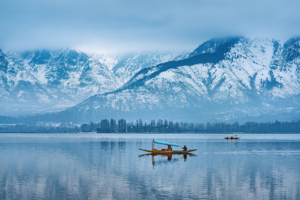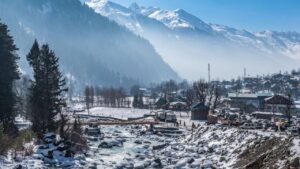Winter Charms in Kashmir
The breathtaking beauty of Kashmir during the harsh winter of Chillaikalan is multiplied, with snow-clad landscapes and frozen water bodies adding to the resilient spirit of the valley's inhabitants.
By Rayees Ahmad Kumar
The most severe stretch of bitterly cold forty days, known as Chillaikalan, has firmly established itself in the awe-inspiring and captivating landscape of the valley. The towering, snow-covered mountain peaks, expansive green grassy meadows, and crystalline water bodies have been drawing people from every corner of the globe since time immemorial. Traders, scholars, and rulers from around the world have relished the scorching hot days of summer in the valley, captivated by its delightful climate and enchanting beauty. It is no wonder that the renowned Persian scholar and poet Amir Khusro penned the famous couplet, “Agar firdous bar roye zamin ast, hame asto hame asto hame ast,” signifying that if there is heaven on earth, it is here, repeated thrice.
Kashmir, not only a preferred destination for national and international visitors during the summer months, continues to allure a significant number of visitors in the wintry months of Chillaikalan, making it an all-weather tourist destination. During the winter months, domestic and foreign skiers flock to Gulmarg and Sonamarg to showcase their skiing prowess. Individuals unfamiliar with snow in their native countries make special trips to the valley, particularly during the New Year celebrations.
In preparation for the New Year celebrations of 2024, the Jammu and Kashmir tourism department made extraordinary arrangements at the world-famous Pahalgam and Sonamarg health resorts to welcome incoming guests. While national and foreign visitors enjoy the charms of Chillai-Kalan for a brief period, the local inhabitants have endured the hardships of the biting cold for centuries.

During Chillai-Kalan, the valley usually transforms into a spectacle of hanging icicles from withered twigs and thatched roofs of traditional kucha houses. Few inches thick icy surfaces cover static water bodies like Dal Lake and Wullar Lake, creating a serene yet challenging environment. Young children engage in games like ice hockey on these frozen water bodies, and motorbikers have been known to relish riding on the icy surfaces of Dal Lake when the mercury plummets below freezing.
The harsh period of Chillaikalan presents a significant challenge for many valley residents, especially those belonging to the impoverished class. Prior to the onset of winter, they must procure woolen and warm clothes for their children, traditional Kangri for each family member, and warm floorings for every room in the house to combat the biting cold. With insufficient electricity and frequent power outages, electrical gadgets provide little relief during troubled times, leaving the Kangri as the sole source of warmth for trembling bodies. However, these winter preparations impose a substantial burden on their finances, as a major portion of their yearly income is dedicated to purchasing and arranging winter essentials.
For the needy and poverty-stricken, enduring the chilly waves during winter in the valley is a tremendous challenge. Unable to afford costly luxury items and electrical gadgets, they live miserably while the wealthy and affluent either escape to Jammu or Delhi to avoid the winter chill or equip their homes with every conceivable appliance and gadget.
Contrary to the opulent class living luxuriously during winter, economically downtrodden individuals rely on sun-dried vegetables from the summer season. The centuries-old practice of keeping essential food items, especially sun-dried vegetables, helps combat food shortages during the chilly days of Chillaikalan when the National Highway, the only link to the valley, frequently closes due to heavy snowfall.
Despite recent warnings from valley-based medics about the carcinogenic effects of sun-dried vegetables, the residents continue the tradition of preparing mixed curries, particularly using sun-dried bottle gourds and chickpeas, to ward off infections and chest-related disorders. Sun-dried dandelion leaves are specifically served to lactating and pregnant women for their significant health benefits.

During winter, the disruption of power lines due to heavy snowfall is a major irritant for valley residents. Prolonged power outages occur when electricity disappears for days, creating challenges for children preparing for yearly examinations after the academic session was shifted to March. The blockage of the national highway further exacerbates the situation, as shopkeepers and traders exploit the situation to artificially hike the prices of essential goods, worsening the economic condition of already impoverished individuals.
For far-off and far-flung areas, the winter period brings tough experiences, with roads leading to district headquarters blocked for weeks or even months. Ailing persons and expectant mothers face dire consequences, with some losing their lives while being transported to hospitals on carts due to the lack of transportation and road blockades. It is crucial to acknowledge the significant role played by the army during such eventualities, facilitating delivery cases in snowy weather conditions and earning our gratitude as unsung heroes during natural calamities.
The views expressed in this article are solely those of the author and do not necessarily reflect the opinions or views of this newspaper


Comments are closed.